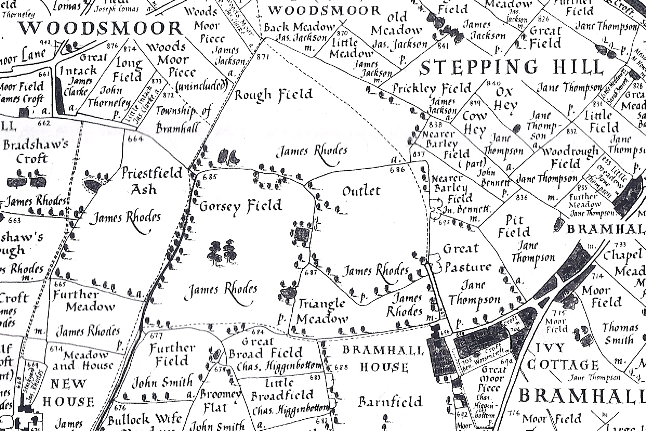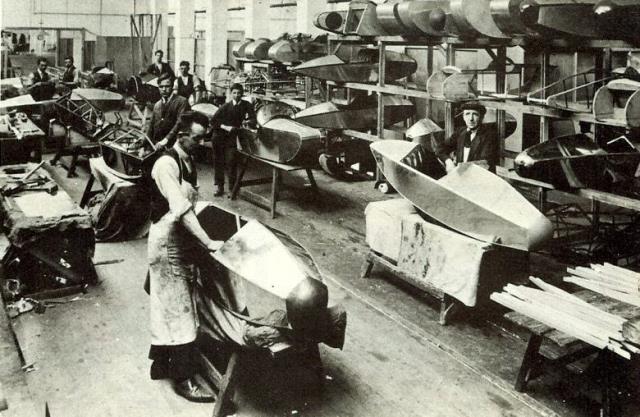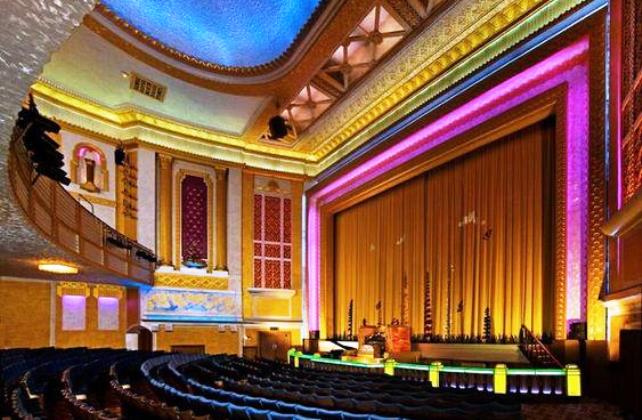 The iconic “black and white bungalow” built on Flowery Field
The iconic “black and white bungalow” built on Flowery Field
Sue Bailey started in an almost apologetic way by explaining exactly where Woodsmoor was. With her knowledgeable audience it was hardly necessary but it served as an excellent introduction. She took us through the evolution of the area, slowly and gradually, starting in 1336, and tracing the changes over the years. But it was not a typical evolution. For example, it got its own railway station only in 1990 - a mere 130 years after the railway first passed through.
Initially, as with so much of the area south of Stockport, it was a peat bog. The names ‘moor’, ‘heath’ and ‘moss’ survive to this day in various districts, giving a clue as to their original condition. Although the name Woodsmoor doesn’t appear until the eighteenth century the moor was there since time immemorial. The first sign of it is as Snibbs Moor in the early 1300s. Snibb is another word for bog so the area was presumably a boggy moor. It remained in this condition whilst Stockport and, later, Bramhall grew in population. The first record of the name Woods Moor is in 1764 but from then on it gradually became the name of choice for the area. Despite  The tithe map of Bramhall North East of 1842the poor soil, by the seventeenth century there were perhaps eight or nine families living in the area, together with four farms. It was part of the manor of Bramhall but the local residents were responsible for improving and maintaining the land, particularly drainage aspects and fines were levied on those failing in their duty..
The tithe map of Bramhall North East of 1842the poor soil, by the seventeenth century there were perhaps eight or nine families living in the area, together with four farms. It was part of the manor of Bramhall but the local residents were responsible for improving and maintaining the land, particularly drainage aspects and fines were levied on those failing in their duty..
These were mostly dairy farms with perhaps a dozen cows but some of the fields were used for growing hay and small amounts of barley and oats for animal feed. Usually the farms supplemented their income with small-scale spinning and weaving. The farm houses were quite substantial with seven or eight rooms plus outbuildings. Over the years there was some consolidation of holdings and the later farms could rear forty or fifty cows and sell cheese in commercial quantities. There were also some cottages for farm labourers and, by the nineteenth century, there were two rather superior houses occupied by the Higginbothams and the Walmsleys. The former had made money producing button moulds for the silk industry whilst the Walmsleys had flour mills and a grocer’s shop. Indeed Thomas Walmsley was mayor of Stockport in the 1820s. There was little industry in this period, the only enterprise being a silk factory called the Spindle Works. The railway arrived in 1857 but instead of bringing industry it merely bisected Woodsmoor. There was no station and for the first twenty years there was not even a crossing with gates. An early photo of the Swallow Sidecar workshops
An early photo of the Swallow Sidecar workshops
Industry or no industry, housing came at last to Woodsmoor in the 1890s as local builders began to buy small plots of land and it was at this time that the iconic “black and white bungalow” was built on Flowery Field. Henry Lomas, an important local builder, was responsible and it was built to high standards of craftsmanship. Local folklore has it that the basement is a ballroom but in actual fact it began as a garage and was only converted to an entertainment room in the 1920s.
A key event in the history of Woodsmoor was in 1908 when Mirrlees, Bickerton & Day estabished their new factory in Hazel Grove, on the edge of Woodsmoor. The factory might not have been in Woodsmoor but the company golf course was. Unfortunately it was turned into a tank testing area during the First World War which did not do the greens much good but it was reinstated after the war and survived as a sports association until 1986. A rather more tenuous claim to industrial fame is that it asserts to be the home of Jaguar Cars. More precisely it was the home of the man who started a business that eventually became Jaguar Cars. William Walmsley, on returning from WW1, designed and built a sidecar for a motor cycle. When his father retired the family moved to Blackpool and William went into partnership with a neighbour, Bill Lyons, in the Swallow Sidecar Company. Soon after they built their first sports car - SS1(Swallow Sidecar 1.)
Another period of housebuilding began in the 1920s and new roads were created rather than just following the old roads. Over 500 houses were built in this period but perhaps the most iconic building was the Davenport Theatre and Cinema which opened in 1937, a classic Art Deco design. It put on a wide variety of entertainment and hosted many famous personalities as well as classic films. It was sold and demolished in 1997 after sixty years of giving pleasure to Woodsmoor residents and many others from further afield. Davenport Theatre
Davenport Theatre
Adapting a phrase used for people, Woodsmoor “had a good war”. Mirrlees, of course, made a huge variety of diesel engines but smaller firms played their part. Kay Brothers, a company making adhesives, were asked to develop their birdlime for a ‘sticky bomb’ - a grenade used as an anti-tank weapon. Although not an unadulterated success, over 2.5 million were produced. After the Second World War there was one more period of house building from 1950 to 1970, but not on a large scale. It was extending existing roads and infilling but there was little land left for extensive house building. In just less than a century the area had changed from being a rural enclave to a modern suburb, close to the centre of Stockport. Sue Bailey took us on this fascinating journey enlivened by her talk and extensive collection of historic photographs.

